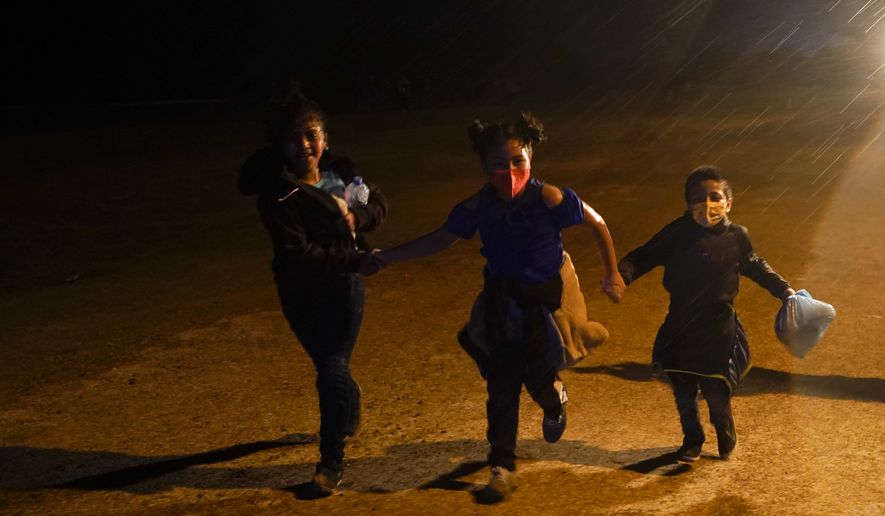The Biden administration appears to have finally stemmed the surge of migrant children who’d been pouring across the border illegally since the start of the year.
They’re still coming, but their numbers have fallen this month from the summer’s catastrophic levels to merely overwhelming numbers, giving both the Border Patrol and Health and Human Services some breathing space.
Over the last five days of public records, only about 1,700 unaccompanied juveniles from beyond Mexico and Canada were caught by Customs and Border Protection agents. That’s the lowest since early June.
And HHS had just 13,273 unaccompanied juveniles in custody as of Monday, the lowest it’s been since March when the surge was just picking up. At one point HHS had more than 22,000 children in its shelters.
The average length of stay for released migrants was also down to 28 days at the end of August, marking the fastest release schedule in years.
The situation is a remarkable turnaround from the late spring and summer when massive numbers of children rushed the border, enticed by a policy change under the Biden team that allowed them to stay rather than be turned back amid the COVID-19 pandemic.
They came in the tens of thousands, stacking up in cells at Border Patrol facilities and crowding the HHS shelters, sparking complaints of mental trauma, COVID-19 fears and suicide worries.
The Biden administration opened new HHS shelters and tossed some of the rules for placing children with sponsors to lower the numbers. At the height, more than 800 children were released to sponsors in one day.
That’s raised questions over whether HHS is moving too quickly.
A recent report by Axios that HHS was unable to reach about one-third of the children or their sponsors in follow-up checks is sparking new worries that the department is trying to push children out the door to keep numbers down, without enough focus on who they are being turned over to.
“How can HHS know that the children are safe if it is unable to contact nearly one-third of the sponsors it has approved?” Rep. Andy Biggs, Arizona Republican, wrote in a letter to HHS last week demanding answers.
HHS didn’t respond to a request for comment but the department, in a policy position spanning multiple administrations, insists that once the children are out of its shelters, they are no longer the responsibility of the government.
Members of Congress have vehemently denounced that stance, citing the department’s policies about follow-up care.
Homeland Security did respond to The Washington Times but didn’t answer questions about the pace of new arrivals. Instead, the department pointed back to Homeland Security Secretary Alejandro Mayorkas’ comments during a visit to Texas last month where he spoke about progress in moving children quickly through his department and on to HHS.
“I should say that, of course, we have unaccompanied children still in Border Patrol custody, but we are moving them much, much faster than we did in March and under the 72 hours that is required by law,” Mr. Mayorkas said.
That is true, though even at the time he spoke the numbers were getting worse. As of Aug. 10, unaccompanied juveniles spent an average of 52 hours in Homeland Security’s custody, or nearly double the 27 hours recorded in June.
In the Rio Grande Valley region, the hardest-hit area for the surge, the average rose from 26 hours in June to 41 hours on Aug. 10.
The Border Patrol was catching more than 500 unaccompanied juveniles a day at that time. The rate over the last week is closer to 350.
The lower numbers don’t erase the heartbreaking stories.
Border Patrol agents on Tuesday patrolling the Rio Grande near Eagle Pass, Texas, spotted colors in the brush along the bank and investigated. They found a 2-year-old girl and a 3-month-old boy abandoned. The infant was in a carrier with a note underneath revealing they were siblings from Honduras.
Last week, Border Patrol agents in Brownsville, Texas, said a 6-year-old Salvadoran boy was abandoned at a Walmart. Authorities say he had contact information for an aunt in Houston his family hoped he would be delivered to.
That’s standard practice for many of the children, whose parents or caretakers send them with names, addresses and phone numbers of relatives already in the U.S. written on their clothing. The parents know the federal government will, in most cases, eventually deliver the children to those people, effectively completing the smuggling route.
In most cases, those relatives here are in the U.S. without permission themselves. The Biden administration has taken steps to shield those people from deportation to get them to come forward and collect the children.
Unaccompanied children have long been seen as the trickiest border cases. Under the law, those from countries that aren’t contiguous to the U.S. — so anywhere other than Canada and Mexico — are required to be processed by Homeland Security and quickly released to HHS. Those from Mexico and Canada can be returned.
While in government custody, the children’s care is also governed by a court overseeing a class-action lawsuit.
A new report ordered by the judge in that case said that as of Aug. 22, HHS had 824 COVID-positive children in its emergency shelters or of about 5,800 total population — a rate of about 14%.
COVID-19 isn’t the only medical issue, though.
Trauma and mental health issues are rampant, according to professionals who have examined the children as part of a class-action lawsuit governing their care.
Other communicable diseases are a more frequent threat, including chickenpox, strep throat, lice and scabies.
• Stephen Dinan can be reached at sdinan@washingtontimes.com.




Please read our comment policy before commenting.